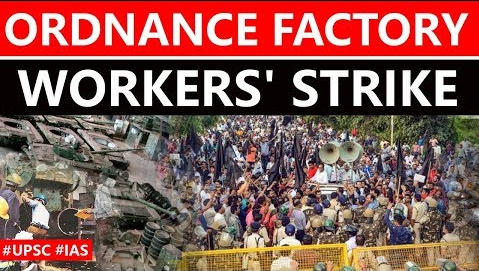Table of Contents

- OFB consisting of the Indian Ordnance Factories functions under the Department of Defence Production of Ministry of Defence, GOI.
- It comprises 41 Ordnance Factories.
- Corporate headquarter- Ordnance Factory Board, Kolkata.
- Oldest organization (1712) run by the GOI.

- It is engaged in research, development, production, testing, marketing and logistics of defence related products.
- Total workforce of about 84,000.
- OFB is the 37th largest defence equipment manufacturer in the world & 2nd largest in Asia.
- Played key role in founding of research and industrial organisations like ISRO, DRDO, BDL, BEML, SAIL, etc.

IN NEWS
- Since 20th August, more than 80,000 workers of the 41 ordnance factories across the country were on strike.
WHAT IS THE ISSUE?
- Workers are protesting against the proposed restructuring of the OFB.
- OFB is currently a department under the Defence Ministry.
- The government plans to convert it into one or more corporate entities fully owned by the government, like the other public sector units. (BHEL, SAIL)
COMMITTEES
- 3 expert committees had suggested such a move—
- T K S Nair Committee (2000)
- Vijay Kelkar Committee on Defence Reforms (2005)
- Raman Puri Committee (2015) — had suggested such a move.
- 4th committee headed by Lt Gen D B Shekatkar, recommended regular performance audits of all ordnance units.
- Corporatisation of ordnance factories was listed as one of the 167 “transformative ideas” to be implemented in the first 100 days of the Modi government’s 2 nd term.

NEED FOR CORPORATISATION?
- The present set-up is inconsistent with modern age requirements.
- Being an arm of the government, the OFB and its factories cannot retain profits. Hence it is difficult to compete with rivals in the private sector.
- Corporatisation will provide operational freedom and flexibility to the OFB & bring OFB at par with other PSUs.
EMPLOYEES CONCERN
- Employees fear that corporatisation is a step towards privatization.
- This may lead to job losses.
- Corporate entity would not be able to survive the unique market environment of defence products.
- Fluctuations in orders, long gaps between orders, uneconomical order quantity.

Latest Burning Issues | Free PDF






















 WhatsApp
WhatsApp